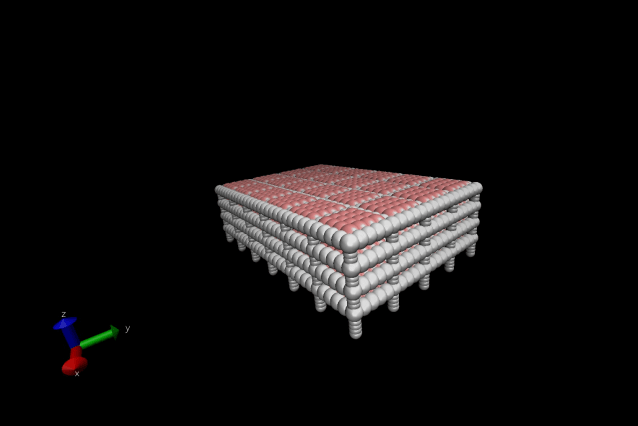Jul 5 2019
Kostas Keremidis, a PhD candidate at the MIT Concrete Sustainability Hub, is utilizing research at the atomic scale to design buildings that can tolerate the largest of storms.
 A building modeled with the molecular dynamics-based structural modeling approach. (Image credit: Kostas Keremidis)
A building modeled with the molecular dynamics-based structural modeling approach. (Image credit: Kostas Keremidis)
Keremidis’ approach partly derives from materials science, and models a building as a series of points interacting via forces like those seen at the atomic scale.
When you look at a building, it is actually a series of connections between columns, windows, doors, and so on. Our new framework looks at how different building components connect together to form a building like atoms form a molecule—similar forces hold them together, both at the atomic and building scale.
Kostas Keremidis, PhD Candidate, Concrete Sustainability Hub, MIT
The framework is known as molecular dynamics-based structural modeling. Ultimately, Keremidis believes that it will offer a new way to builders and developers to instantly predict the damage caused to buildings from disasters like earthquakes and hurricanes.
Making Models
However, before predicting the damage caused to buildings, Keremidis needs to assemble a model first.
He starts by taking a building and segregating its respective elements into “atoms” or nodes. This procedure is standard and is known as “discretization”; it involves dividing a building into different points. Subsequently, Keremidis gives different characteristics to each “atom” based on its material. For instance, the weight of each “atom” may rely on if it is a part of a window, a door, a floor, and so on. He then models them and defines their bonds.
A building model, known as an axial bond, constitutes the first type of bond between points. The axial bond shows how elements tend to deform under a load in their span direction—simply put, it models how a column reduces in size and subsequently rebounds under a load, similar to a spring. Angular bonds are the second type of connection, representing how elements, such as a beam, are able to bend in the lateral direction.
Using these lateral vertical and interactions, Keremidis models the deformation and breaking of various building elements. Extreme deformation of these bonds leads to breakage, just like in actual structures.
In order to observe how one of his buildings will withstand under hazard conditions like earthquakes or storms, Keremidis would need to meticulously test these assembled atoms and their bonds under various simulations.
Once I have my model and my building, I then run around 10,000 simulations. I can assign 10,000 different loads to one element or building, or I can also assign that element 10,000 different properties.
Kostas Keremidis, PhD Candidate, Concrete Sustainability Hub, MIT
In order to evaluate the outcomes of these simulated properties or conditions, Keremidis returns to the bonds. “When they deform during a simulation, these bonds will try to bring the building back to its original position,” he observed. “But they may also get damaged, too. This is how we model damage—we count how many bonds are destroyed and where.”
The Damage is in the Details
As a matter of fact, the innovations of the model lie in its damage prediction.
Engineers have traditionally employed a technique known as finite element analysis to model the damage caused to buildings. Similar to MIT’s method, this technique also breaks down a building into component parts.
However, it is usually time-intensive and is set up around the elements’ elasticity. This implies that this technique can model only slight deformations in a building, instead of large-scale inelastic deformations, such as fracture, that often takes place under hurricane loads.
The molecular dynamics model provides an additional advantage—Keremidis can play with the layout and nature of atoms and their bonds to explore “different materials, different structural properties, and different building geometries.” This implies that any element of a building could be modeled by the molecular dynamics, and more rapidly as well.
This molecular dynamics—by scaling this method beyond individual buildings—could also better inform state, city, and also federal hazard-mitigation efforts.
The Federal Emergency Management Agency (FEMA), known as HAZUS, is currently used by cities for hazard mitigation. A dozen standard building models and historical weather data are required to predict the damage that might be experienced by a community at the time of a hazard.
While HAZUS is useful, it is definitely not an ideal tool. It provides just about a dozen standardized building types and offers qualitative, instead of quantitative, results.
However, the MIT model will enable stakeholders to go into a more intricate detail.
With FEMA’s HAZUS, the current level of categorization is too coarse. Instead, we should have 50 or 60 building types. Our model will allow us to collect and model this wider range of buildings types.
Kostas Keremidis, PhD Candidate, Concrete Sustainability Hub, MIT
Since a molecular dynamics method quantifies damage by counting the broken bonds between atoms, it will also measure the damage inflicted on a community by hazards like windstorms or earthquakes in a much easier way. Such a measurable understanding of the damage caused by hazards should result in more precise estimations of mitigation costs and recovery.
At present, wind storms account for $28 billion in damage every year, according to the U.S. Congressional Budget Office. They will cause $38 billion by 2075, owing to coastal development and climate change.
A molecular dynamics approach will allow government agencies and developers to have an additional tool to predict and reduce such damages.
The MIT Concrete Sustainability Hub is a research team from a number of departments across MIT working on economics, engineering, and concrete and infrastructure science. Its studies are supported by the Portland Cement Association and the Ready Mixed Concrete Research and Education Foundation.